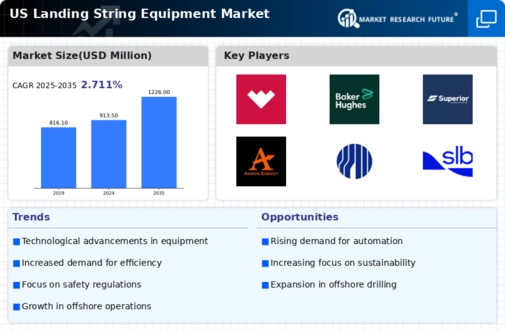Increased Demand for Safety Equipment
The landing string-equipment market experiences heightened demand due to an increasing emphasis on safety protocols in various industries. As organizations prioritize worker safety, the need for reliable landing string equipment becomes paramount. This trend is particularly evident in sectors such as construction and aerospace, where safety regulations are stringent. The market is projected to grow at a CAGR of approximately 5.5% over the next five years, driven by the necessity for compliance with safety standards. Companies are investing in advanced landing string technologies to enhance safety measures, thereby propelling the landing string-equipment market forward. Furthermore, the integration of smart technologies into safety equipment is likely to attract more investments, indicating a robust future for the industry.
Technological Integration and Innovation
The landing string-equipment market is witnessing a surge in technological integration and innovation, which is reshaping the industry landscape. The advent of automation and smart technologies is enhancing the functionality and efficiency of landing string equipment. For instance, the incorporation of IoT devices allows for real-time monitoring and data analytics, which can improve operational safety and performance. This trend is likely to attract significant investments, with the market projected to reach $1.2 billion by 2027. Companies are increasingly focusing on research and development to create innovative solutions that meet the evolving needs of various industries, thereby driving growth in the landing string-equipment market.
Expansion of Aerospace and Defense Sectors
The landing string-equipment market is significantly influenced by the expansion of the aerospace and defense sectors in the US. With increasing government budgets allocated to defense and aerospace projects, there is a corresponding rise in demand for landing string equipment. The US defense budget for 2025 is estimated to exceed $800 billion, which is likely to bolster investments in advanced landing string technologies. This growth is not only limited to military applications but also extends to commercial aviation, where safety and efficiency are critical. As the aerospace sector continues to innovate, the landing string-equipment market is expected to benefit from the adoption of cutting-edge technologies, thereby enhancing operational capabilities and safety standards.
Rising Investment in Infrastructure Projects
The landing string-equipment market is poised for growth due to rising investments in infrastructure projects across the US. Government initiatives aimed at improving transportation networks, bridges, and public facilities are driving demand for landing string equipment. The Biden administration's infrastructure plan, which allocates $1.2 trillion for various projects, is expected to significantly impact the market. As construction activities ramp up, the need for reliable landing string equipment becomes increasingly critical to ensure safety and efficiency. This influx of investment is likely to create new opportunities for manufacturers and suppliers within the landing string-equipment market, fostering innovation and competition.
Growing Focus on Training and Skill Development
The landing string-equipment market is also influenced by a growing focus on training and skill development within industries that utilize such equipment. As the complexity of landing string technologies increases, there is a corresponding need for skilled personnel who can operate and maintain these systems effectively. Organizations are investing in training programs to ensure that their workforce is equipped with the necessary skills, which in turn drives demand for advanced landing string equipment. This emphasis on skill development is likely to enhance safety and operational efficiency, contributing positively to the growth of the landing string-equipment market. Furthermore, partnerships between equipment manufacturers and training institutions are emerging, indicating a collaborative approach to workforce development.




















Leave a Comment